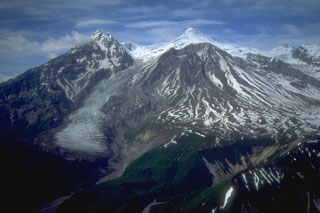Report on Spurr (United States) — January 1993
Bulletin of the Global Volcanism Network, vol. 18, no. 1 (January 1993)
Managing Editor: Lindsay McClelland.
Spurr (United States) Continued seismicity
Please cite this report as:
Global Volcanism Program, 1993. Report on Spurr (United States) (McClelland, L., ed.). Bulletin of the Global Volcanism Network, 18:1. Smithsonian Institution. https://doi.org/10.5479/si.GVP.BGVN199301-313040
Spurr
United States
61.299°N, 152.251°W; summit elev. 3374 m
All times are local (unless otherwise noted)
Seismicity has continued at Spurr from mid-January through mid-February, but there have been no eruptive episodes since 16-17 September 1992. The number of locatable earthquakes beneath Crater Peak, to depths of 30 km, has remained at a level of 0-3/day during this period. Deeper seismicity (>15 km depth) and locatable events within 10 km of the volcano gradually declined in late 1992 and early 1993, consistent with the possibility that magma is no longer being supplied to the shallow system. Seismicity at 5-15 km and <5 km depths remained low, but above background levels, in mid-February. There were 0-4 locatable seismic events during the week of 5-12 February, all of which were shallow.
Geological Summary. Mount Spurr is the closest volcano to Anchorage, Alaska (130 km W) and just NE of Chakachamna Lake. The summit is a large lava dome at the center of a roughly 5-km-wide amphitheater open to the south formed by a late-Pleistocene or early Holocene debris avalanche and associated pyroclastic flows that destroyed an older edifice. The debris avalanche traveled more than 25 km SE, and the resulting deposit contains blocks as large as 100 m in diameter. Several ice-carved post-collapse cones or lava domes are present. The youngest vent, Crater Peak, formed at the southern end of the amphitheater and has been the source of about 40 identified Holocene tephra layers. Eruptions from Crater Peak in 1953 and 1992 deposited ash in Anchorage.
Information Contacts: AVO.

